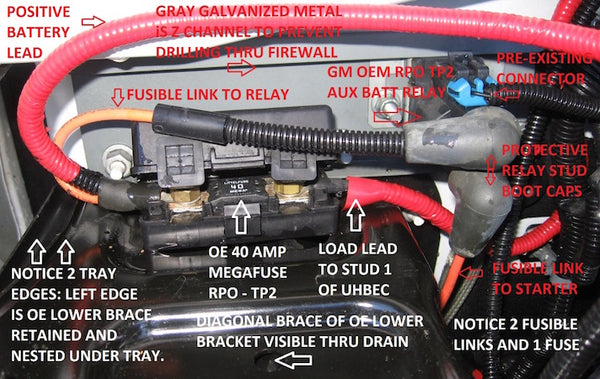Whether you're buying a winch, a portable fridge, or installing a massive stereo system, someone has probably suggested that you upgrade to a dual battery system. That way, you'll have ample electrical power to keep your vehicle operating (power for the starter and basic electrical system) while powering your accessories and add-ons.
We're going to explain how dual battery systems are supposed to work for common applications, and then illustrate how the ArkPak can serve as a portable 2nd battery in a dual battery system (as well as a portable power source for camping, tailgating, boating, etc.).
Dual Battery System Setup and Function
Most dual battery setups looks something like this:

- The existing stock battery (we'll call it battery #1) is connected to an isolator, as is the new add-on battery (we'll call it battery #2)
- The isolator is designed to automatically prevent battery #1 from being discharged when the vehicle is 'OFF'. The isolator may or may not have a manual switch to override this setting.
- When the vehicle is 'ON' and the alternator is providing electricity, the isolator "opens" to allow power to flow into both battery #1 and battery #2.
When you're vehicle is parked and not running, battery #1 (usually a starter battery) is isolated from the electrical system and can not be discharged. Battery #2 (which is often a deep-cycle battery) provides all power when the vehicle is off. This way, you don't have to worry about "killing" you starter battery if you plug in a fridge, or run your winch, etc. etc.
Generally speaking, the battery isolator and wiring you need to install a dual battery system in a normal vehicle is a couple hundred dollars, plus you need a mounting tray for your second battery, plus you may need an extended length of low gauge wire if you have to mount your 2nd battery in the rear of your vehicle. The costs can easily reach $300-$400...and that does NOT include the cost of the 2nd battery itself.
The Problem With Typical Dual Battery Systems
While dedicated dual battery systems have some benefits - automatic charging of your 2nd battery, and top-tier systems are compatible with large current draws - they have a series of drawbacks:

Image courtesy ChevyAvalanchFanClub.com
- Cost. A typical dual battery system setup is a $300-$400 expense by the time you buy the isolator and associated wiring, the mounting kit for your 2nd battery, and whatever additional wiring you need.
- Complexity. Installing a dual battery system is easy compared to say, installing a supercharger, but much harder than changing your oil. Often times the 2nd battery must be mounted in the rear of a vehicle, as there's no room under the hood. If a mistake is made during the wiring process, the isolator won't work as advertised. You could find that both your vehicle batteries are dead at the worst possible time.
- It's only for your vehicle. When you install a dual battery system in your vehicle, it stays in your vehicle. If you want to use that battery to power some accessories while camping or tailgating, for example, you're going to have to practically camp or tailgate inside your vehicle. If you want to use that power while boating, you need a vehicle that changes into a boat, or you need a battery booster for your boat.
While vehicle mounted dual battery systems are great for heavy-duty and commercial applications where current requirements are substantial, they're not terribly practical for people who need power while camping, tailgating, boating, etc. For most users, a dedicated dual battery system is a waste of money.
Using The ArkPak As A Virtual, Portable Dual Battery System
If you purchase the ArkPak bundle, the included DC-DC charger will give you nearly all the benefits of a typical dual battery system (power to operate accessories when the vehicle is off, recharging when the vehicle is on), but you won't be married to an expensive and essentially permanent dual battery setup.
Here's how you do it:
- When you start driving your vehicle, plug the ArkPak's 12V DC-DC charger into a standard cigarette lighter outlet in your vehicle. The ArkPak will begin to charge.
- When you stop your vehicle and shut off the engine, unplug your ArkPak. You're officially isolated from the vehicle electrical system.
- Run all your accessories off the ArkPak's built-in 12VDC outlets (just like the outlets in your vehicle). If you run down the battery in your ArkPak, not to worry: your vehicle's electrical system is just fine.
That's it! No wires to run, no trays to mount, no isolators to worry about, etc. Just plug it in when the engine is on and unplug when it's off. You can even mount the ArkPak inside your vehicle with the mounting bracket provided in the bundle.
In an emergency, you can open the ArkPak up and hook standard jumper cables to the battery inside the ArkPak, essentially the same setup as a typical dual battery system.

Since the ArkPak can accommodate a battery as large as Group 31, you can get as much as 130ah of 12VDC electricity out of your ArkPak. What's more, you can take your ArkPak wherever you go - camping, boating, tailgating, etc., and you can even use the ArkPak as a self-sustaining energy system in conjunction with some solar panels.
Like we said, there are situations where a dedicated vehicle dual battery makes sense. But for something like running a portable fridge, or making sure you have power just in case your vehicle battery dies when you're winching, the ArkPak is a much better choice than a typical dual battery system.
